HPF detector, orders, and fibers
The HPF detector is a 2048x2048 pixel 1.7 micron cutoff H2RG detector, controlled by a SIDECAR ASIC and a SAM interface board. Data are obtained using 4 readout amplifiers (channels), in the up-the-ramp mode. Channels run vertically on the detector (e.g. Ch1: 512:1023,0:2047; Ch2: 0:511,0:2047; etc.). The detector has 2040 x 2040 active pixels surrounded a 4 pixel wide band of non-light-sensitive reference pixels. Reference pixels are retained in all 2d images.
There are 3 separate spectra that fall on the detector from 3 separate fibers as follows:
| Fiber | Description |
|---|---|
| Sky fiber | Fiber on the sky offset from the science fiber for taking a spectrum of the sky emission. The spectrum from this fiber can be used to subtract sky lines from the science spectrum. |
| Science fiber | Fiber placed on the science target by the HET. Contains the spectrum of the science target. |
| Calibration fiber | Fiber connected to the HPF calibration bench. Normally it contains the spectrum of the laser frequency comb for simultaneous wavelength calibration with each science spectrum for precision-RV measurements. For low S/N or non-precision-RV targets, the comb is generally turned off. |
The light from a single echelle order for a single fiber is called a “beam.” The HPF echellogram consists of 28 orders repeated for each of the 3 fibers for a total of 84 beams.
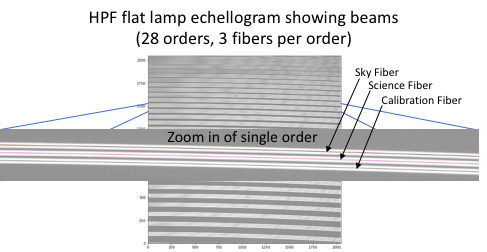
Where the data are stored
The HPF data are stored at the Texas Advanced Computing Center (TACC, https://www.tacc.utexas.edu) and accessed in a similar fashion to other HET instruments. For information on creating accounts and logging into TACC see: https://hydra.as.utexas.edu/?a=help&h=56
Data are organized by “date” and “observation number”. Dates are the UT date of the observation in the format YYYYMMDD. Each ramp (exposure) has its own four digit observation number (OBSNUM). Observation numbers start at 1 for the first ramp in a night, and simply increment upwards for each following ramp.
All the HPF data are stored in the following directory on TACC:
/work/03946/hetdex/maverick/YYYYMMDD/hpf/raw/OBSNUM/
/work/03946/hetdex/maverick/YYYYMMDD/hpf/reduced/OBSNUM/
./raw/ directories contain the unprocessed up-the-ramp fits files
./reduced/ directories contain processed slope images and extracted, wavelength calibrated spectra
The nightly manifests
Manifests are electronically generated observing logs that list all ramps taken for each night. They are formatted in fixed-width format columns. Each night’s manifest is separated by noon local time at HET so that all the calibrations (evening and morning) are listed with the associated science data. Note that the evening calibrations mostly have UT dates from the day before the science data is taken. Manifests are useful for identifying the ObsNum corresponding to you data, as well as identifying calibration frames that you may want.
The manifests are all stored in the named as hpf_YYYYMMDD.list in the base hpf directory for each night (e.g. /work/03946/hetdex/maverick/YYYYMMDD/hpf/).
Example manifest for UT Date of 20180526:
UT-Timestamp UT-Date ObsNum Frame ObsType iTime QProg Object
2018-05-25T21:28:33.952 20180525 0040 Slope-20180525T212805_R01.fits Sci 213.0 LFC_CalibTest
2018-05-25T22:28:58.484 20180525 0041 Slope-20180525T222831_R01.fits Cal 319.5 Dark
2018-05-25T22:39:05.903 20180525 0042 Slope-20180525T223838_R01.fits Cal 85.2 Alpha Bright Cal
2018-05-25T22:41:13.814 20180525 0043 Slope-20180525T224046_R01.fits Cal 85.2 Alpha Bright Cal
2018-05-25T22:43:21.892 20180525 0044 Slope-20180525T224254_R01.fits Cal 85.2 Alpha Bright Cal
2018-05-25T22:45:29.766 20180525 0045 Slope-20180525T224502_R01.fits Cal 85.2 Alpha Bright Cal
2018-05-25T22:47:37.495 20180525 0046 Slope-20180525T224709_R01.fits Cal 85.2 Alpha Bright Cal
2018-05-25T22:49:45.580 20180525 0047 Slope-20180525T224917_R01.fits Cal 85.2 Alpha Bright Cal
2018-05-25T22:51:53.505 20180525 0048 Slope-20180525T225124_R01.fits Cal 85.2 Alpha Bright Cal
2018-05-25T22:54:01.507 20180525 0049 Slope-20180525T225338_R01.fits Cal 85.2 Alpha Bright Cal
2018-05-25T22:56:09.252 20180525 0050 Slope-20180525T225545_R01.fits Cal 85.2 Alpha Bright Cal
2018-05-25T23:21:01.701 20180525 0051 Slope-20180525T232031_R01.fits Sci 468.6 Alpha Bright FCU
2018-05-25T23:31:20.194 20180525 0052 Slope-20180525T233050_R01.fits Cal 479.25 Alpha Bright FCU
2018-05-25T23:40:02.488 20180525 0053 Slope-20180525T233938_R01.fits Cal 479.25 Alpha Bright FCU
2018-05-25T23:48:44.854 20180525 0054 Slope-20180525T234819_R01.fits Cal 479.25 Alpha Bright FCU
2018-05-25T23:58:31.178 20180525 0055 Slope-20180525T235803_R01.fits Cal 106.5 LFC FCU
2018-05-26T00:01:00.323 20180526 0001 Slope-20180526T000036_R01.fits Cal 106.5 LFC FCU
2018-05-26T00:03:29.646 20180526 0002 Slope-20180526T000303_R01.fits Cal 106.5 LFC FCU
2018-05-26T00:05:58.857 20180526 0003 Slope-20180526T000530_R01.fits Cal 106.5 LFC FCU
2018-05-26T00:08:28.198 20180526 0004 Slope-20180526T000803_R01.fits Cal 106.5 LFC FCU
2018-05-26T00:10:57.402 20180526 0005 Slope-20180526T001030_R01.fits Cal 106.5 LFC FCU
2018-05-26T00:14:09.278 20180526 0006 Slope-20180526T001339_R01.fits Cal 159.75 LFC Cal
2018-05-26T00:17:31.793 20180526 0007 Slope-20180526T001703_R01.fits Cal 159.75 LFC Cal
2018-05-26T00:20:54.258 20180526 0008 Slope-20180526T002027_R01.fits Cal 159.75 LFC Cal
2018-05-26T00:24:16.815 20180526 0009 Slope-20180526T002351_R01.fits Cal 159.75 LFC Cal
2018-05-26T00:27:39.522 20180526 0010 Slope-20180526T002716_R01.fits Cal 159.75 LFC Cal
2018-05-26T00:31:02.089 20180526 0011 Slope-20180526T003034_R01.fits Cal 159.75 LFC Cal
2018-05-26T00:34:45.949 20180526 0012 Slope-20180526T003417_R01.fits Cal 159.75 Etalon Cal
2018-05-26T00:38:08.473 20180526 0013 Slope-20180526T003742_R01.fits Cal 159.75 Etalon Cal
2018-05-26T00:41:31.052 20180526 0014 Slope-20180526T004106_R01.fits Cal 159.75 Etalon Cal
2018-05-26T02:28:07.032 20180526 0015 Slope-20180526T022738_R01.fits Cal 958.5 UNe Slave Cal
2018-05-26T02:44:49.105 20180526 0016 Slope-20180526T024422_R01.fits Cal 958.5 UNe Slave Cal
2018-05-26T03:01:31.231 20180526 0017 Slope-20180526T030106_R01.fits Cal 958.5 UT18-2-005 UNe Slave Cal
2018-05-26T03:57:07.794 20180526 0018 Slope-20180526T035637_R01.fits Sci 330.15 HR4131
2018-05-26T04:04:03.586 20180526 0019 Slope-20180526T040334_R01.fits Sci 319.5 HR4131_lfc
2018-05-26T04:34:05.163 20180526 0020 Slope-20180526T043337_R01.fits Sci 511.2 PSU18-2-004 CM_Dra
2018-05-26T04:50:25.938 20180526 0021 Slope-20180526T044955_R01.fits Sci 308.85 ENG18-2-003 GJ_436
2018-05-26T04:56:17.727 20180526 0022 Slope-20180526T045548_R01.fits Sci 308.85 ENG18-2-003 GJ_436
2018-05-26T05:02:09.516 20180526 0023 Slope-20180526T050141_R01.fits Sci 308.85 ENG18-2-003 GJ_436
2018-05-26T05:21:52.723 20180526 0024 Slope-20180526T052123_R01.fits Sci 308.85 PSU18-2-004 PM_J17464+2743W
2018-05-26T06:43:36.440 20180526 0025 Slope-20180526T064306_R01.fits Sci 308.85 ENG18-2-003 GJ_699
2018-05-26T06:49:28.199 20180526 0026 Slope-20180526T064859_R01.fits Sci 308.85 ENG18-2-003 GJ_699
2018-05-26T06:55:19.928 20180526 0027 Slope-20180526T065452_R01.fits Sci 308.85 ENG18-2-003 GJ_699
2018-05-26T07:01:11.850 20180526 0028 Slope-20180526T070044_R01.fits Sci 308.85 ENG18-2-003 GJ_699
2018-05-26T07:07:03.530 20180526 0029 Slope-20180526T070637_R01.fits Sci 308.85 ENG18-2-003 GJ_699
2018-05-26T07:20:12.524 20180526 0030 Slope-20180526T071944_R01.fits Sci 330.15 PSU18-2-003 G_227-22
2018-05-26T07:26:25.564 20180526 0031 Slope-20180526T072602_R01.fits Sci 319.5 PSU18-2-003 G_227-22
2018-05-26T07:32:28.013 20180526 0032 Slope-20180526T073200_R01.fits Sci 330.15 PSU18-2-003 G_227-22
2018-05-26T07:45:26.172 20180526 0033 Slope-20180526T074459_R01.fits Sci 159.75 PSU18-2-004 G_227-22
2018-05-26T07:54:40.652 20180526 0034 Slope-20180526T075412_R01.fits Sci 308.85 PSU18-2-004 GJ_725B
2018-05-26T08:07:38.675 20180526 0035 Slope-20180526T080709_R01.fits Sci 330.15 PSU18-2-008 KELT9
2018-05-26T08:18:29.045 20180526 0036 Slope-20180526T081759_R01.fits Sci 724.2 PSU18-2-004 PM_J16148+6038
2018-05-26T08:31:16.581 20180526 0037 Slope-20180526T083052_R01.fits Sci 713.5500 PSU18-2-004 PM_J16148+6038
2018-05-26T09:24:45.295 20180526 0038 Slope-20180526T092415_R01.fits Sci 468.6 PSU18-2-004 PM_J16139+3346
2018-05-26T10:16:27.459 20180526 0039 Slope-20180526T101557_R01.fits Sci 681.6 PSU18-2-004 PSU18-2-004
2018-05-26T10:28:32.388 20180526 0040 Slope-20180526T102807_R01.fits Sci 681.6 PSU18-2-004 PSU18-2-004
2018-05-26T10:53:24.722 20180526 0041 Slope-20180526T105255_R01.fits Cal 319.5 Dark
2018-05-26T11:00:20.516 20180526 0042 Slope-20180526T105951_R01.fits Cal 106.5 LFC FCU
2018-05-26T11:02:49.832 20180526 0043 Slope-20180526T110225_R01.fits Cal 106.5 LFC FCU
2018-05-26T11:05:18.955 20180526 0044 Slope-20180526T110452_R01.fits Cal 106.5 LFC FCU
2018-05-26T11:07:48.214 20180526 0045 Slope-20180526T110719_R01.fits Cal 106.5 LFC FCU
2018-05-26T11:10:17.496 20180526 0046 Slope-20180526T110952_R01.fits Cal 106.5 LFC FCU
2018-05-26T11:12:46.755 20180526 0047 Slope-20180526T111219_R01.fits Cal 106.5 LFC FCU
2018-05-26T11:15:47.934 20180526 0048 Slope-20180526T111520_R01.fits Cal 106.5 LFC Cal
2018-05-26T11:18:17.259 20180526 0049 Slope-20180526T111753_R01.fits Cal 106.5 LFC Cal
2018-05-26T11:20:46.592 20180526 0050 Slope-20180526T112020_R01.fits Cal 106.5 LFC Cal
2018-05-26T11:23:15.772 20180526 0051 Slope-20180526T112247_R01.fits Cal 106.5 LFC Cal
2018-05-26T11:25:44.819 20180526 0052 Slope-20180526T112520_R01.fits Cal 106.5 LFC Cal
2018-05-26T11:28:14.159 20180526 0053 Slope-20180526T112747_R01.fits Cal 106.5 LFC Cal
2018-05-26T11:30:43.511 20180526 0054 Slope-20180526T113015_R01.fits Cal 106.5 LFC Cal
2018-05-26T11:33:12.790 20180526 0055 Slope-20180526T113248_R01.fits Cal 106.5 LFC Cal
2018-05-26T11:35:41.949 20180526 0056 Slope-20180526T113515_R01.fits Cal 106.5 LFC Cal
2018-05-26T11:38:53.883 20180526 0057 Slope-20180526T113825_R01.fits Cal 202.35 Alpha Bright FCU
2018-05-26T11:42:59.096 20180526 0058 Slope-20180526T114234_R01.fits Cal 213.0 Alpha Bright FCU
2018-05-26T11:47:57.526 20180526 0059 Slope-20180526T114731_R01.fits Cal 85.2 Alpha Bright Cal
2018-05-26T11:50:05.474 20180526 0060 Slope-20180526T114938_R01.fits Cal 85.2 Alpha Bright Cal
2018-05-26T11:52:13.443 20180526 0061 Slope-20180526T115146_R01.fits Cal 85.2 Alpha Bright Cal
2018-05-26T11:54:21.405 20180526 0062 Slope-20180526T115354_R01.fits Cal 85.2 Alpha Bright Cal
2018-05-26T11:56:29.333 20180526 0063 Slope-20180526T115602_R01.fits Cal 85.2 Alpha Bright Cal
2018-05-26T11:58:37.275 20180526 0064 Slope-20180526T115810_R01.fits Cal 85.2 Alpha Bright Cal
2018-05-26T12:00:45.149 20180526 0065 Slope-20180526T120018_R01.fits Cal 85.2 Alpha Bright Cal
2018-05-26T12:02:53.122 20180526 0066 Slope-20180526T120226_R01.fits Cal 85.2 Alpha Bright Cal
2018-05-26T12:05:01.079 20180526 0067 Slope-20180526T120434_R01.fits Cal 85.2 Alpha Bright Cal
2018-05-26T12:07:40.995 20180526 0068 Slope-20180526T120712_R01.fits Cal 106.5 LFC Cal
2018-05-26T12:10:10.231 20180526 0069 Slope-20180526T120946_R01.fits Cal 106.5 LFC Cal
2018-05-26T12:12:39.464 20180526 0070 Slope-20180526T121213_R01.fits Cal 106.5 LFC Cal
2018-05-26T12:17:48.564 20180526 0071 Slope-20180526T121721_R01.fits Cal 159.75 Etalon Cal
2018-05-26T12:21:11.233 20180526 0072 Slope-20180526T122044_R01.fits Cal 159.75 Etalon Cal
2018-05-26T12:24:33.659 20180526 0073 Slope-20180526T122408_R01.fits Cal 159.75 Etalon Cal
2018-05-26T12:27:56.319 20180526 0074 Slope-20180526T122733_R01.fits Cal 159.75 Etalon Cal
2018-05-26T12:31:40.286 20180526 0075 Slope-20180526T123110_R01.fits Cal 958.5 UNe Slave Cal
2018-05-26T12:48:22.235 20180526 0076 Slope-20180526T124755_R01.fits Cal 958.5 UNe Slave Cal
2018-05-26T13:05:04.257 20180526 0077 Slope-20180526T130439_R01.fits Cal 937.2 UNe Slave Cal
Fixed-width columns of the manifests:
| Column Number | Character range | Column Name | Description |
|---|---|---|---|
| 1 | 3-26 | UT-Timestamp | Universal time a ramp was taken in format YYYY-MM-DDTHH:MM:SS.SSS |
| 2 | 27-37 | UT-Date | UT Date ramp was taken in format YYYYMMDD |
| 3 | 38-46 | ObsNum | Observation number for the ramp |
| 4 | 47-89 | Frame | Name of frame that is used for the slope image (2D echellogram) and 1D extraction fits files |
| 5 | 90-99 | ObsType | The observation type as either science (sci), calibration (cal), or engineering (eng) |
| 6 | 100-117 | iTime | Integration (exposure) time in seconds |
| 7 | 118-145 | QProg | HET queue program ID for science data. Blank for calibration or engineering data. |
| 8 | 146-188 | Object | Name of science target or calibration type |
If you are using astropy.io.ascii fixedwidth to read the manifest files, the column start,stop could be the following
(3,27), (27,38), (38,47), (47,90), (90,100), (100,118), (118,146), (146,189)
Observation Types
There are three types of observations taken at HPF, denoted by the FITS header keyword “ObsType.” They are science (sci) observations, calibrations (cal), and engineering (eng) data. You will need to know which science observations are yours; calibration data is standardized, and is taken twice per night for all projects (unless you requested special cals). The science observations are identified by HET queue program ID (“QProg” in the manifest) and the associated calibrations are listed as “cal” in the same night’s manifest.
Nightly Calibrations
The nightly calibrations are taken in the evening before and the morning after each night’s science observations. Note that occasionally morning and/or evening cals are not taken due to various circumstances (e.g. scheduled hardware maintenance). The types of calibrations are as follows:
| Calib. Type | Fiber(s) | Description |
|---|---|---|
| Dark | None | Exposure with no calibration lamp on. For quality/engineering checks. Observers probably won’t need this. |
| Alpha Bright Cal | Cal | Alpha Bright flat lamp through calibration fiber. The Alpha Bright is a tungsten source of ~3000K. Used for finding the location of beam traces and as the beam profile for the optimal 1D extractions. |
| Alpha bright FCU | Sci & Sky | Alpha Bright flat lamp light sent through HET FCU to science and sky fibers. Used for finding the location of beam traces and as the cross-dispersion profile for the optimal 1D extractions. |
| LFC FCU | Sci & Sky | The laser frequency comb is the primary wavelength reference source for HPF. The LFC spectrum is locked in frequency space, and the frequency of any individual line is known absolutely. LFC light is sent through HET FCU to science and sky fibers, and used to measure the relative offset between these fibers and the calibration fiber. |
| LFC Cal | Cal | LFC light through the calibration fiber. Used for nightly wavelength calibration. |
| Etalon Cal | Cal | Etalon light through the calibration fiber. This is a secondary wavelength reference source, and used as a backup to the laser frequency comb for wavelength calibration. The etalon provides a reference fencepost of evenly spaced calibration lines, but the wavelength of these lines is unknown and must be derived from a primary source (e.g. LFC or UNe). The etalon has a known long-term drift. If the LFC was working during your observations, you will not need the etalon data. Etalon data is obtained coincident to LFC data during each calibration sequence, so that the etalon can be bootstrapped to the LFC. If the LFC goes down during the night, the RA will revert to using the Etalon as the simultaneous calibrator. |
| UNe Slave | Cal | Uranium Neon arc lamp through the calibration fiber. This is a primary wavelength reference source, and is used as a backup to the laser frequency comb and etalon for wavelength calibration. The UNe is not useful as a simultaneous calibrator due to scattered light from the bright Ne lines. Mainly for engineering purposes, observers probably won’t need to use this. |
Raw output, up-the-ramp reads
The raw data “.fits” files are unprocessed and there likely no need to use the raw data unless you want to fully reduce the data yourself. They are provided for completeness.
Data with HPF are read out in an “up-the-ramp” (UTR) mode. Each exposure denoted by observation number is called a “ramp”. A ramp consists of 2 or more “reads” taken every 10.65 seconds. Each read is non-destructive, meaning that the instantaneous pixel data value and the collection of photons are unaffected by the act of reading a pixel. Multiple reads per ramp allow the readnoise of the detector to be averaged down. The individual pixel units are counts. The detector system (including readout electronics) has a gain of 2.5 e-/count.
The total exposure time for a ramp is given as:
Exp. time = (N-1)*(10.65 s)
Where N is the number of reads.
Ramp files are named with a timestamp that represents the machine time of when the ramp was started (Note that this time is different by 10-30 s of when the first frame was obtained due to overheads in the SIDECAR. The DATE-OBS header keyword reflects the correct time of exposure).
The filename of ramp files is: hpf_YYYMMDDThhmmss_R01_FNNN.fits where NNN is the read number.
Tarballs of the FITS files of the raw individual reads for a given ramp are stored in the ./raw/ subdirectories in each nightly directory.
Readout Glitches
HPF was commissioned using a SAM electronics board as the interface between the SIDECAR and the computer. This board has a buggy interface driver that causes ‘glitches’ in the readout. These glitches manifest (typically) as extraneous rows of pixels inserted into the data stream. Good data is rolled up, and data pushed off the edge of a given image is wrapped to the bottom of the next image.
Most of the glitched data is recoverable from raw images that the instrument team saves for every ramp. We correct the glitches after the fact, reassembling ‘whole’ images. These reassembled images are the UTR frames stored on the TACC in the ./raw/ directories.
The typical consequence of a glitch is that the overall exposure actually achieved is 1 frame shorter in duration than the exposure that was intended. On rare occasions, 2 frames are lost. This exposure time discrepancy has been properly accounted for in the ITIME header keyword.
Our automated glitch correction algorithm works quite well, but occasionally fails to reassemble the image pixels in the correct order. This can easily be detected in the ./raw/ frames because the spectrograph beams will jump in position from one frame to the next, and the reference pixels will no longer be aligned at the edges of the detector. If you discover such a problem, please contact the instrument team with Date and ObsNum, and we will investigate if your data can be recovered (the answer is likely to be ‘yes’). HPF is currently developing an alternative electronics control board which will deploy in Fall 2018 and should produce glitch free data.
Slope Images (2D Echellograms)
The HPF pipeline, cleans up the bias fluctuations in the “up-the-ramp” data, applies non-linearity correction, and cosmic-ray recovery to create a clean data cube. More details of these algorithms are provided in SPIE: 107092U Figure on the right shows a typical example of the up-the-ramp readout of a pixel, and the nonlinearity corrected line. Slope estimates of each pixel are used to generate a 2D slope (flux) image from the 3D “up-the-ramp” data. These slope images are stored in FITS files at the following location on TACC:
DATE/hpf/reduced/OBSID/Slope-YYYMMDDThhmmss_R01.fits
The Slope fits images have the following four extensions: 1. Flux (slope) image in units of e-/sec 2. Variance image which provides the pixel level variance of the flux estimate in the first extension. (unit: (e-/sec)^2) 3. Number of non-destructive reads used in the slope calculation of each pixel form the up-the-ramp data. 4. An array of average “up-the-ramp” curves of different region of interests. These one-dimensional summary of the increase in the counts during the ramp exposure is provided for diagnostic purpose. The mask defining those regions are provided on the TACC at /work/03946/hetdex/maverick/HPF_Processed/MasterCals/HPFmask_liberal_v5.fits
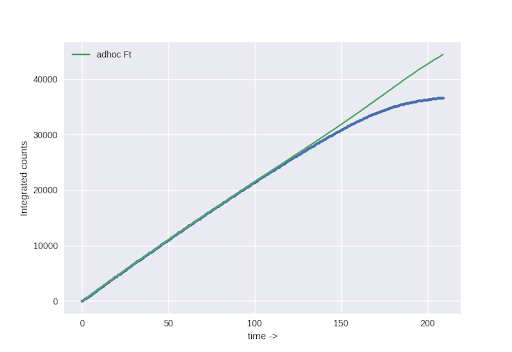
1D Extracted Spectra
The HPF data reduction pipeline extracts each 2D slope image into a 1D spectrum as follows:
- The slope image is flat fielded using a scattered light flat that illuminates the entire detector area. This corrects achromatic pixel-to-pixel QE variations. It does not correct for the instrument response, nor for chromatic QE. To correct these effects, see the section below “Flat Fielding with Alpha Brights”
- Mask static bad pixels. This mask is provided in the ancillary data products folder on TACC.
- Trace the beams and extract with an optimal extraction algorithm (e.g. Horne 1986). The cross-dispersion profile has been derived from Alpha Bright flats. Beams are rectified prior to extraction using the flux conserving polygon clipping algorithm from Smith et al. 2013
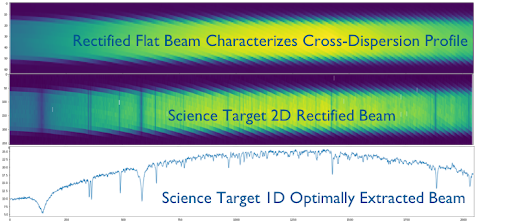
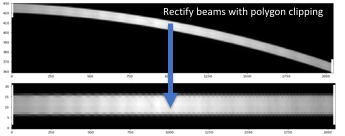
An instrumental drift corrected wavelength solution is provided in the last three extensions of the extracted spectrum. The instrumental drift is calculated by linear interpolation of the drift estimates from the nearest data containing LFC comb in cal fiber. The drift corrected wavelength solution is calculated at an order by order basis by interpolating the drift value to the flux weighted midpoints of each order. If the S/N of the flux rate curve during an exposure is less than 2, then the curve is averaged across the orders for a more stable solution. The chromatic flux weighted midpoint of each order matter only if one is doing precision RV on bright targets. The master wavelength solution itself is calculated by fitting the comb lines in the Laser Frequency comb data. The pixel level wavelength solution of each extracted pixel is stored like an image array in the same format as the flux arrays. The wavelengths are all provided in vacuum wavelengths (unit: Angstroms).
The final 1D optimally extracted spectra flux, variance, and wavelength solutions are stored in FITS files as 2D arrays with the following FITS extensions:
- Science fiber flux in units of (e-/sec)
- Sky fiber flux in units of (e-/sec)
- Calibration fiber flux in units of (e-/sec)
- Science fiber variance in units of (e-/sec)^2
- Sky fiber variance in units of (e-/sec)^2
- Calibration fiber variance in units of (e-/sec)^2
- Science fiber’s wavelength per pixel (Vacuum wavelength in Angstroms)
- Sky fiber’s wavelength per pixel (Vacuum wavelength in Angstroms)
- Calibration fiber’s wavelength per pixel (Vacuum wavelength in Angstroms)
The x-axis of the 2D arrays correspond exactly to the x-axis on the detector and the y-axis correspond the the echelle order (1-28) starting from bluest on the top row to reddest on the bottom row. The array reads like a book (left-to-right and top-to-bottom) in order of increasing wavelength.
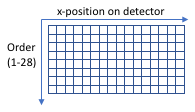
FITS header keywords added for 1D extractions
- Primary Extension
- E_VER - Extraction code version number.
- “vX.YZ”
- E_GIT - Extraction code current git commit
- Long string of letters and numbers for git commit to https://github.com/psuastro/HPFdrs
- RECTIF - Are rectified beams used for 1D extraction?
- Always true ”T”
- EXTRACT - Type of 1D extraction (“optimal” or “sum”)
- Always “optimal”
- CHECKSUM - HDU checksum
- DATASUM - data unit checksum
- Always “0” for primary extension
- E_VER - Extraction code version number.
- Extension 1 (or higher)
- XTENSION - Extension type added by astropy.io.fits. Always an image for the extraction code outputs.
- Always “IMAGE”
- BITPIX - Array data type added by astropy.io.fits. Always 32 bit floating point.
- Always “-32”
- NAXIS - Number of dimensions in array stored in fits extension. 2 for 1D extractions
- Always “2” for 1D extractions
- NAXIS1 - Number of pixels in dimension 1
- Always “2048” for HPF
- NAXIS2 - Number of pixels in dimension 2
- “28” for number of orders in HPF 1D extractions
- PCOUNT - Number of parameters. Added by astropy.io.fits.
- Always “0”
- GCOUNT - Number of groups. Added by astropy.io.fits.
- Always “1”
- EXTNAME - Type of data stored in this extension. Name of fiber and then name of datatype
- “Sci/Sky/Cal Flux/Variance” for extractions or rectified beams
- CTYPE1 - Units type for dimension 1 pixels.
- Always “X” *CTYPE2 - Unit type for dimension 2 pixels
- Always “Order”
- CHECKSUM - HDU checksum
- DATASUM - data unit checksum
- XTENSION - Extension type added by astropy.io.fits. Always an image for the extraction code outputs.
Flat fielding with Alpha Brights
This version of data release does not do a flat fielding in the 2D image before extraction using the continuum source Alpha Bright Cals taken everyday. However, before the extraction step, we do a zeroth order flat correction of quantum efficiency and gain differences the pixels using a median filtered scattered light flat. (Normalisation by the median filtered smooth image of the scattered light flat is to remove low frequency components in the scattered light pattern, which are not true pixel effects). This step does not correct for the high frequency instrumental response nor the chromatic QE of the detector pixels. Hence it is important to flat field the spectrum using alpha bright. Since HPF’s slit is rectangular and there is minimal wavelength overlap in extraction of pixels along the slit, to a good extent it suffices to flat field the extracted spectrum using the extracted alpha bright frames. Nightly cals taken routinely include alpha bright frames (Alpha Bright Cal: for Cal fiber) and (Alpha Bright FCU: for Sci and Sky fibers). If flat fielding is done using the extracted spectrum, it is important to use the same optimal extracted spectrum generated by the pipeline. For the data taken in the Shared Risk period (2018 May to July), the alpha brights taken in Sci and Sky fibers via FCU head, suffers from modal noise. Hence, one should be careful interpreting any continuum structures less than 1% after using Alpha Bright FCU flats. If available, we recommend using flats generated from A or B type standard stars. HPF detector has an epoxy void which is known to behave differently from frame to frame. It is recommended to be careful to interpret any features which falls along the edges of this void.
In future releases, we will be providing better flat corrected data for the user community.
![]()
Auxiliary Files
On the TACC cluster at the following directory
/work/03946/hetdex/maverick/HPF_Processed/MasterCals
we have kept the following auxiliary files which would be useful for the community:
- HPFmask_liberal_v5.fits
- Bad pixel mask
- HPF_NFlAT_20180203.fits
- Scattered light flat field
- HPF_DiagnosticRegionMask28Nov2017.npy
- An array with the regions used for the diagnostic average up-the-ramp curves stored in the 4th extension of the slope images.